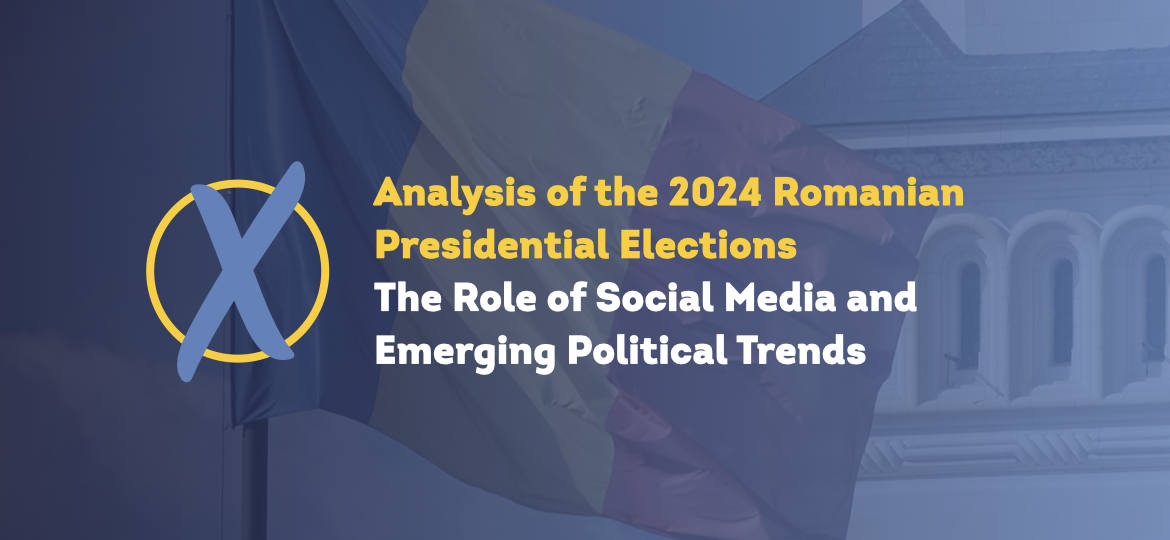Analysis of the 2024 Romanian Presidential Elections: The Role of Social Media and Emerging Political Trends
1. Introduction
This report examines the significant events and dynamics surrounding the Romanian presidential elections of 2024, focusing on the unexpected rise of candidate Călin Georgescu and some insights into the impact of social media, particularly TikTok. The analysis covers user engagement, candidate performance, key findings, and implications for the future political landscape.
2. TikTok’s Role in Romanian Politics
2.1 Overall TikTok Landscape
- User Base: TikTok boasts approximately 8.9 million users in Romania.
- Political Engagement: Political hashtags have consistently occupied prominent positions in trending topics, largely due to accounts supporting presidential candidates. TikTok’s prohibition of paid political advertising was largely ineffective, primarily due to what we believe to be insufficient content moderation.
2.2 Candidate Performance Metrics
- George Simion: Demonstrated a strong viral presence with 240.6 million views on key hashtags, supported by a robust network of accounts.
- Marcel Ciolacu: Achieved 208.9 million views, primarily from non-official sources, resulting in significantly lower engagement on his official account. His content reflected a mix of positive and negative sentiments.
- Elena Lasconi: Experienced steady organic growth, reaching 123 million views, predominantly driven by engagement from youth accounts affiliated with the USR party.
- Călin Georgescu: Notably surged in popularity, garnering 120 million views, particularly in the final two months. This increase was attributed to coordinated campaigns that used both direct promotion and indirect influence via unpaid influencers, often lacking appropriate labeling. A salient example is the #echilibrușiverticalitate campaign, which reached 2.4 million views through these tactics.
3. Key Findings and Observations
3.1 Content Regulation Deficiencies
The lack of effective moderation allowed for widespread dissemination of unverified information, particularly affecting extreme-right candidates.
Concerns around unlabelled or undeclared political content in the 2024 Romanian presidential elections, particularly on TikTok are significant. They emphasize a lack of transparency in political campaigns, notably involving candidates like Călin Georgescu, who used the platform without disclosing the funding and motivations behind their promotion. The employment of influencers without adequate disclosure raises ethical issues complicates voters’ understanding of the content.
3.2 Influence of Coordinated Campaigning
Coordinated campaigning—both direct and indirect—played a crucial role in enhancing the viral spread of candidates’ content.
3.3 Use of Influencers
The strategic use of influencers for candidate promotion, often without clear disclosures, was a widespread tactic, mirroring the campaign approach employed by Alexandr Stoianoglo in Moldova.
3.4 Emergence of Counter-Campaigns
Counter-campaigns emerged to combat misinformation, particularly regarding Călin Georgescu, creating a reactive environment fueled by rapid information dissemination.
4. Unexpected Election Outcomes
4.1 Călin Georgescu’s Surprising Victory
Călin Georgescu, an independent candidate with far-right and pro-Russian rhetoric, unexpectedly won over 22% of the votes in the first round of the presidential elections, contradicting pre-election polls and expert predictions. Factors contributing to this outcome included:
- Strategic Use of Social Media: Georgescu effectively utilized TikTok to convey simplistic, nationalist messages that resonated with voters.
- Voter Disillusionment: A widespread disillusionment with traditional political parties drove voters toward supporting an emerging candidate.
- Anti-Establishment Sentiment: The electorate’s significant anti-establishment feelings facilitated Georgescu’s candidacy.
4.2 Discrepancy Between Predictions and Results
The notable gap between projected poll figures (around 10%) and actual results (over 22%) raises concerns about potential external influences, including foreign interference.
4.3 Data Analysis Insights
- Late Surge in Support: Pre-election polls indicated a growing support trajectory for Georgescu, yet the abrupt increase in his final vote share was unforeseen.
- Social Media Analysis: Google Trends data revealed a late escalation in interest for Georgescu that was not mirrored in traditional media coverage, underscoring the importance of alternative data sources in electoral dynamics.
- Ongoing Uncertainties: The factors contributing to Georgescu’s success, including anti-establishment sentiment and social media strategies, present challenges in fully explaining the magnitude of his victory. The possibility of foreign interference remains a pertinent concern.
5. Future Implications
5.1 Rise of Far-Right Sentiment
Georgescu’s unexpected success signals a burgeoning far-right and pro-Russian sentiment in Romania, which raises concerns about the country’s future relations with the EU and NATO.
5.2 Governance and Institutional Challenges
Ongoing challenges related to governance, institutional integrity, and corruption continue to be significant factors in political discourse.
5.3 Economic Considerations
Economic issues, such as inflation and increasing energy costs, are anticipated to play a vital role in shaping future political conversations.
References
Expert Forum Romania with supporting organization (NED, National Endowment for Democracy)
https://expertforum.ro/en/extremism-and-momentum-how-calin-georgescu-has-risen-in-the-polls/
BROD analyses of Presidential Election Dynamics in Romania compiled by Funky Citizens and SNSPA researchers as part of BRODHub.
More insights from BROD
Author: BROD
